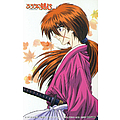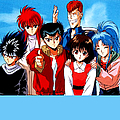Saint Seiya Biography
Please note that "Saint Seiya" isn't the name of the composer of the music score for the anime series, being actually 横山菁児 (Seiji Yokoyama) the actual composer. Please fix your tags. Also known as Knights of the Zodiac, it's a manga/anime that tells the story of some youngsters that fights to protect the Goddess Athenea. Very popular inside and outside Japan, and inspired in constellations and greek history, was created by Masami Kurumada in 1986. Saint Seiya (聖闘士星矢, Seinto Seiya?), also known as Knights of the Zodiac, is a manga and anime series about a group of five mystical warriors called the "Saints" (or "Knights") who have adopted various constellations as their guardian symbols. Manga series See also: List of Saint Seiya Chapters The Saint Seiya manga is authored by Masami Kurumada and was first published in Weekly Shonen Jump magazine from January 1986 to December 1990. It was later collected into 28 tankōbon volumes starting in September 1986. The series has three main parts: Sanctuary (volumes 1 to 13), Poseidon (14 to 18), and Hades (19 to 28). The 13th volume also contains a separate short story called Blue Warriors. In December, 2002, serialization began in Champion Red magazine of a new manga called Saint Seiya Episode G. This new work is written by Masami Kurumada and drawn by Megumu Okada. The story happens years before the Galactic Tournament, and focuses on the Gold Saints and the Sanctuary, particularly on Leo Aiolia, all against Cronos and his Titans. On April 27, 2006, Masami Kurumada, after 16 years of interruption, begins his new work: Saint Seiya - Next Dimension - Meiō Shinwa ("The Knights of The Zodiac - Next Dimension - The Lord of the Underworld Myth") on Weekly Shonen Champion. The relationship between former Pegasus saint and Hades during the holy war 243 years ago is expected to be revealed in the new serial. The first installment of the serial, which is published on Weekly Shonen Champion, has been released on August 3, 2006. Saint Seiya - Next Dimension A new manga series, this time made by Kurumada, has been released. The first chapters (each being 8 pages long) were published between August and September, 2006 (first chapter published on August 3). This manga introduction relates the part just after Seiya and the other Bronze Saints attack god Hades in Elysion, all Bronze Saints have their God Cloth. Then, Athena will be seen fighting with Hades. But the main part is where we see from Hades' memories, where he seems to be a friend of the previous Pegasus Saint. This is part of the ancient times of the 1740s, the previous Holy War. Here, we also see a young Shion of Aries and Dohko of Libra who were revealed to be originally Bronze Saints, before being promoted to Gold. Kurumada has announced that after the success of the first three chapters he will continue to publish them weekly for some time after the fourth chapter has been published. At the same time, a new Saint Seiya manga, The Lost Canvas, has been announced. TV series in Japan The anime is based on the manga series of the same title (above). The animation series by Toei Animation first premiered in Japan's TV Asahi on October 11, 1986. Masami Kurumada said that he doesn't like the anime, but agreed to transfer the manga to anime because of a tradition of make an anime from every manga. The first anime series was produced by Toei Animation from 1986 to 1989. It was directed first by Kōzō Morishita (episodes 1 to 73) and then by Kazuhito Kikuchi (episodes 74 to 114). The character designers were Shingo Araki and Michi Himeno, and Seiji Yokoyama composed the soundtracks. The chief script writers were Takao Koyama and Yoshiyuki Suga. It has three main parts: Sanctuary (episodes 1 to 73), Asgard (74 to 99), and Poseidon (100 to 114). The Asgard arc does not exist in the manga and was made directly for the anime. There have also been five theatrical releases (three short movies and two full-length ones), which do not belong to the regular chronology, as they contain several story line contradictions. The movies are Saint Seiya (Saint Seiya Gekijōban), The Great Battle of the gods (Kamigami no Atsuki Tatakai), The Legend of the Hot Blooded Boys (Shinku no Shonen Densetsu), Warriors of the Last Holy War (Saishūseisen no senshitachi) and Heaven Chapter - Overture (Tenkai-hen Josō). Hades Saga Chapter Sanctuary The first 13 episodes of an OVA series corresponding to the Hades saga were broadcasted on Animax (a Japanese pay-per-view channel) from November, 2002 to April, 2003, and then released on DVD during the year 2003. Before that, the Hades saga could only be seen in the manga. These 13 episodes were named Hades - Chapter Sanctuary (Meiō Hades Jūni-Kyū Hen). This OVA series was directed by Shigeyasu Yamauchi, still with character designs by Shingo Araki and Michi Himeno, and with scripts written this time by Michiko Yokote, and soundtracks entirely taken from Yokoyama's work on the previous TV series. Chapter Inferno Two years after the first part of the Hades saga, Chapter Sanctuary, a second part was produced in 2005. This second chapter was named Hades - Chapter Inferno Part 1 (Meiō Hades Meikai Hen Zenshō) and consists of six episodes. However, most of the original seiyu have not reprised their roles. For example, Masakazu Morita replaced Toru Furuya as the voice of Pegasus Seiya, Yūta Kasuya replaced Ryo Horikawa as the voice of Andromeda Shun, Hiroaki Miura replaced Koichi Hashimoto as the voice of Cygnus Hyoga, Katsuyuki Konishi replaced Hideyuki Hori as Phoenix Ikki, Takahiro Sakurai replaced Hirotaka Suzuoki as the voice of Dragon Shiryu and Fumiko Orikasa replaced Keiko Han as the voice of Saori Kido/Athena. Hideyuki Tanaka, however, reprises his role as the narrator. Hirotaka Suzuoki, the original voice actor of Dragon Shiryu, passed away on August 6, 2006 due to lung cancer. Toei Animation released on the same Animax channel the first two OVAs on December 17, 2005, followed by the next two on January 21, 2006. The last pair were released on February 18, 2006. Shortly after their TV broadcasting, (for 2 months) they were released on DVD in 2006. This short OVA series was directed by Tomoharu Katsumata, again with character designs by Shingo Araki and Michi Himeno, with scripts by Yosuke Kuroda and soundtracks still taken from Yokoyama's previous works on the TV series of 1986 (but Yokoyama composed 2 new tracks for this OVA). On July 4, 2006, the newly released Saint Seiya Vol. 15 manga (Japan Complete Version) brings a news: Hades - Chapter Inferno Part 2 (Meiō Hades Meikai Hen Kōshō) anime has been started on July. Toei Animation officially announces the news on its website on July 18, 2006. It has been decided that Hades - Chapter Inferno Part 2, which contains 6 episodes in total, will be released from December, just like the first Meikai OVA series. The first two episodes of Inferno Part 2 will be shown on Japan's Sky Perfect TV from December 15, 2006 to January 4, 2007, with the next two episodes on Sky Perfect from January 19, 2007 to February 1, 2007 and the last two from February 16, 2007 to March 1, 2007.[1] The Hades saga will not end in Chapter Inferno Part 2, perhaps there will be a Chapter Elysion. There is a pre-production poster where the 12 Gold Saints appear to launch their attacks on the Sighing Wall, the entrance to Elysion. Foreign releases English Knights of the Zodiac logo.Saint Seiya began to be known in the West as Knights of the Zodiac after it became successful in France at the end of the 1980s, where it was given the name of Les Chevaliers du Zodiaque. This was also the very first release of the series outside Asia, in 1988. Indeed, France is known to be the first country, outside Japan and Asia, which has a "manga culture" for a long time, since the end of the 1970s. The series was also broadcast starting from 1989 in Italy, under the title of "I Cavalieri dello Zodiaco" (following the French renaming). This edition is known to differ substantially from other foreign editions of Saint Seiya, not only because many names of characters, places, and fighting techniques were changed, but also because the whole tone of the dialogues was modified to become more aulic and ceremonious, with occasional quotations from various pieces of poetry and classical literature; the main characters were also given adult voices in the dubbing, instead of teenage voices. The series was also released in Spanish-speaking countries, under the title of "Los Caballeros del Zodiaco" (again, following the French renaming), enjoying great success in both Spain and Latin America. Currently, the old episodes (Sanctuary, Odin and Poseidon saga's) and the new one's (Hades Saga, with new dubbing) are being aired again on Cartoon Network's Toonami programming block The series was released in Portuguese-speaking countries too, like Portugal and Brazil, "Os Cavaleiros do Zodíaco" following the French renaming, like in Italy and Spain), the series was and still is very famous in both countries. The series aired in North America starting only on August 30, 2003, on Cartoon Network at 7:00 P.M. on a Saturday. Called Knights of the Zodiac, the series was heavily edited for television. The censorship issues were partly due to the fact that the US rights were held jointly by DiC and ADV Films, with DiC owning the TV rights to the series and ADV Films holding the DVD rights. The US "Knights of the Zodiac" version was heavily panned by fans of the series, due to the extensive amount of editing used to remove the violence, bloodshed, and religious themes (blood was colored blue and called sweat; fans have joked that characters "bleed Gatorade", characters were said to be imprisoned rather than being killed, and in a particularly infamous change among fans, when Shiryu slit his wrists to repair the damaged cloths it was called his "mystic energy"). While the characters retained their names and the bulk of their back stories (only Phoenix Ikki's back story was changed for the US dub, with his evil mentor Guilty and his daughter not dying, simply being separated), Saori Kido was turned from wealthy corporation owner to a princess named Sienna in the US dub. The US dub also featured all new music, most notably a cover of the A Flock of Seagulls' song "I Ran" as its theme song performed by the punkrock band Bowling for Soup. Also, the characteristics for some characters (especially Hyoga, who talks like a stereotypical surfer, and Shun, who lacks the weakness of character that was his trademark) are diverse from the original version, leading to further controversy. Another factor in the show's failing was low ratings, which led to Cartoon Network moving the show to 12:30 a.m. late Saturday/early Sunday morning timeslot. The series was pulled after 32 episodes. ADV Films, sensing the backlash, quickly rushed out an uncensored DVD release of the series with the original music restored and the US voice actors providing a more serious accurate dub. The DVDs were successful and appealed to the hardcore fans of the show and quickly went up until episode 60 of the series before ADV Films stopped production of the series. According to ADV Films, they originally only bought the US rights to 60 episodes and that Toei, for unknown reasons, decided to not renew their contract with ADV Films to allow them to dub and release the remaining 54 episodes. As it stands, ADV Films has implied that they will at least attempt to get Toei to allow them to release the remaining 13 episodes of the Sanctuary Saga (which makes up the first 73 episodes of the series) and have re-released the single disc sets of Saint Seiya into two 30 episode/6 disc box sets to drum up interest in the series, but no move has been made yet. It is unknown whether or not The Hades Chapter OVA or any of the other following soon after titles will ever be licensed in the US, but some speculate that since the 2003 Hokuto no Ken (Fist of the North Star) OVA series Shin Hokuto no Ken (New Fist of the North Star) was given a full US release, despite the fact that the original series went unlicensed past episode 36, it may still be possible, especially since the R2 release contains a 23-minute recap episode, explaining everything you need to know about the series before watching the Hades Chapter, making the original license slightly unnecessary. VIZ Media's English language adaptation of the manga (titled: Saint Seiya: Knights of the Zodiac) has been extremely successful and has recently seen the release of volume 18 (completing sancturary and poseidon) out of the 28 volumes in total of the manga series. The US Manga version uses the DiC dub names for the main characters, but for the most part remains extremely accurate in terms of story presentation. The series was intermittently successful in other countries, attaining a cult series status outside Japan, France and the US. It had tremendous impact in Indonesia and the Philippines. In Brazil, for example (where it is known as Os Cavaleiros do Zodíaco), the debut of the series in September 1994 was responsible for changing the face of animation in the country, truly popularizing Japanese animation for the first time. This was also true in other countries of Latin America, especially Panama, Dominican Republic, Bolivia, Costa Rica, Guatemala, El Salvador,Ecuador, Colombia, Mexico, Peru, Chile, Argentina, Paraguay, Uruguay and Venezuela, although shows like Robotech and Mazinger Z had been shown in many of these nations during the previous decade. Both anime and manga were introduced into Hong Kong and Taiwan as 聖闘士星矢 as early as 1987, and started the trend of Japanese manga and animation among those areas. It was introduced into Mainland China as 圣斗士星矢 (anime) and 女神的圣斗士 (manga) around 1990. For example, the anime TV episodes were first broadcasted in Shanghai, the largest city in China, in late January, 1992. Although Japanese animation was no stranger to Chinese audience at that time, Saint Seiya gained a certain popularity.[citation needed] The Spanish Version in Latin America was dub in Mexico with a HUGE success, Saint Seiya opened the door to new anime series like Dragon Ball or Sailor Moon, it was broadcasted in open television, since 1993 with episodes on Saturday at 7am, turning it into a two episode on Saturday at morning, and other one episode per day repetition from Monday to Friday on the evening, that lasted for years. The series was hugely successful in Brazil and the Brazilian audience saw it aired in open television, with episodes running in the morning and reprising in the afternoon from Monday to Saturday. After the conclusion of the Sanctuary part, it was reprised on a two episodes per day basis and then Asgard and Poseidon followed with the ordinary one episode per day broadcasting. All of the episodes were broadcasted in this manner and were then reprised. In 2006 the full 114 episodes were released on DVD and VHS with the original Japanese and Portuguese dubs, as 21 volumes, each with 3 to 4 episodes. It was followed by the release of Hades also in DVD, as a 4 volume, again with 3 to 4 episodes each. Volume 1 and 2 were released in June, 2006 and volumes 3 and 4 were released in August of the same year. With the 2003 comeback of the series on Brazilian television, the Japanese soundtrack received a Portuguese language version which maintained the original instrumentation with new versions for the lyrics only. The opening and closing themes (Pegasus Fantasy and Blue Forever respectively) were recorded by famous heavy metal singer Eduardo Falaschi from Brazilian metal band Angra, coincidentally a huge success, platinum artist in Japan. The series was also aired in Belgium and Portugal (where it was known as Os Cavaleiros do Zodíaco) and in Poland as well (with polish lector on French version, it was known as Rycerze Zodiaku - The Knights of the Zodiac). In Portugal the show was 6 years canceled, since 1992 to 1993 and just aired 36 episodes alleging violent content, returning in 19th September 1999 in SIC without transmitting the episode 37 of 1st Season. The series suffered a long delay before it finally gained entry into the United States market more than a decade later. Saint Seiya has a combination of realistic human characters and violent/death scenes, which explains why it had more trouble with censorship than animes that are far more violent, but less realistic in appearance. It may be said that Saint Seiya has special contributions in the development of Japanese manga and anime culture by laying the groundwork for the "God Warriors" genre of manga/anime and has been cited as having considerable influence on the series Ronin Warriors. A number of anime fans believe the possibility that the anime may have had some influence on the popular anime Sailor Moon. And there are also some similarities with Tokyo Mew Mew and a striking resemblance between sanctuary arc and characters (gold saints) and Soul society arc and Captains of Bleach.
Top Saint Seiya Lyrics
Write a comment
What do you think about Saint Seiya? Let us know in the comments below!
Saint Seiya Albums
| Title | Release | ||
|---|---|---|---|
| 1 | Other Songs A - Y |












